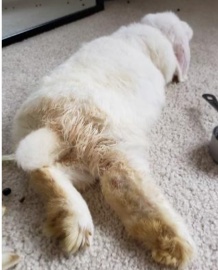Urine Scald Dermatitis in Pet Rabbits
Rabbits that are unintentionally urinating on themselves or sitting in their own urine for prolonged periods can develop urine scald. Urine scald occurs when urine is left to soak onto the fur and skin which results in fur loss, inflammation and/or ulceration and infection (burning) of the skin. This can occur for several reasons including: 1) litter box not cleaned frequently enough, 2) the rabbit is unable to assume the proper stance for urination, or 3) medical problems resulting in the rabbit producing too much urine or an inability to control urine retention/voiding. A rabbit’s litter box should be changed frequently. At the very least every other day; however, every day would be ideal. If you are seeing excessive urine staining on the fur or urine scalding despite appropriate husbandry, please bring your pet in for evaluation.
Some problems that can result in a rabbit being unable to assume the proper stance and become predisposed for urine scalding include: obesity, arthritis, fractures, balance disorders (example: rabbits with head tilt), paralysis, splayed legs, etc. Rabbits with kidney disease may produce excessive amounts of urine resulting in urine scald. Rabbits with urinary tract infections or bladder stones or sludge may urinate more frequently and in abnormal locations, resulting in scald. Rabbits with an injury or infection (such as Encepalitozoon cuniculi) causing damage to the nervous system or may have urinary incontinence resulting in urine scald. Diagnostic testing to understand why your pet has urine scald may include bloodwork, urinalysis and urine culture, radiographs , and E. cuniculi testing. Treatments often include antibiotics, pain relievers, fur shaving, careful bathing, and skin care/protection.




